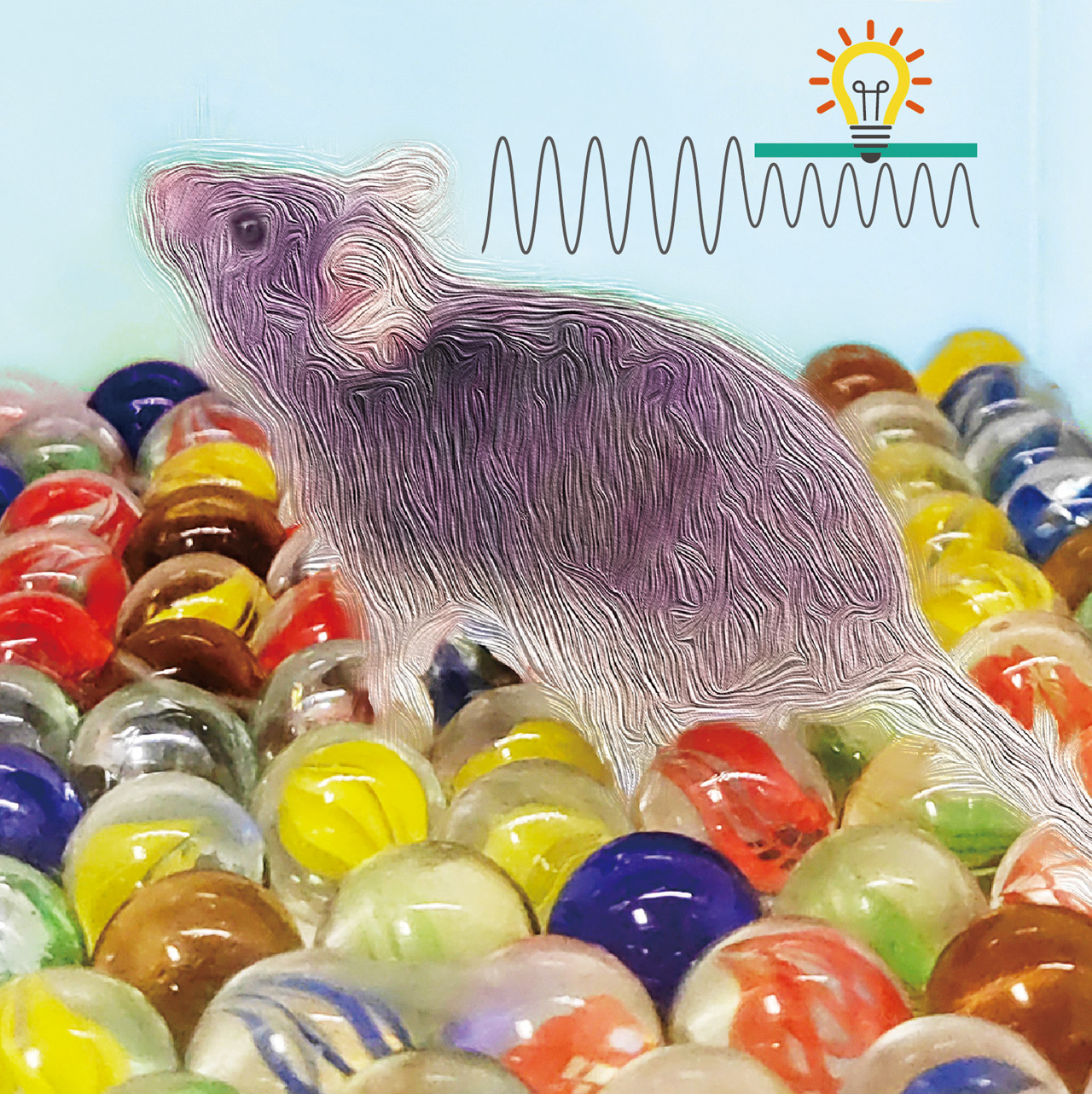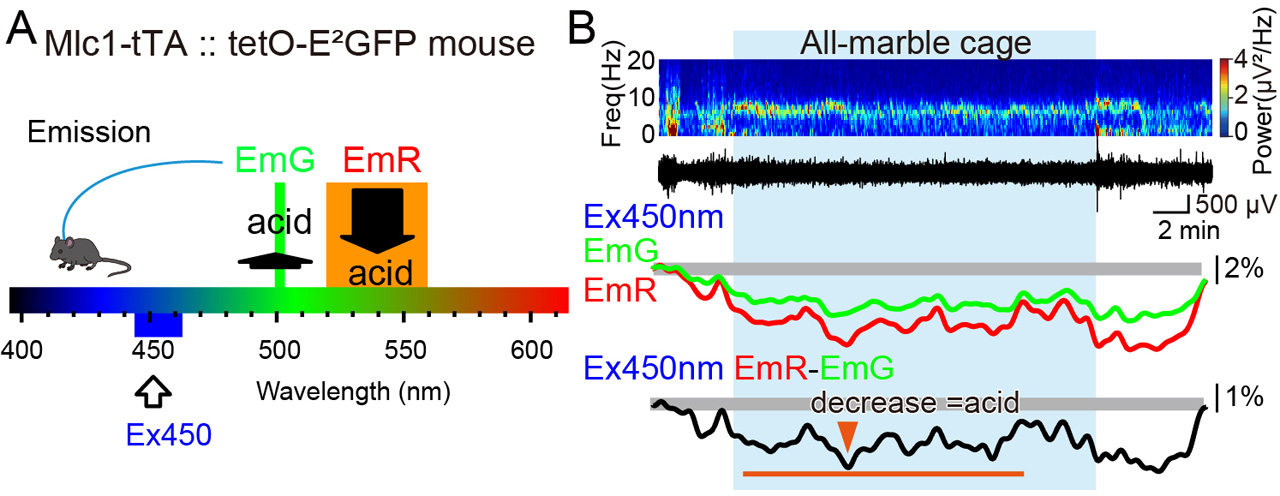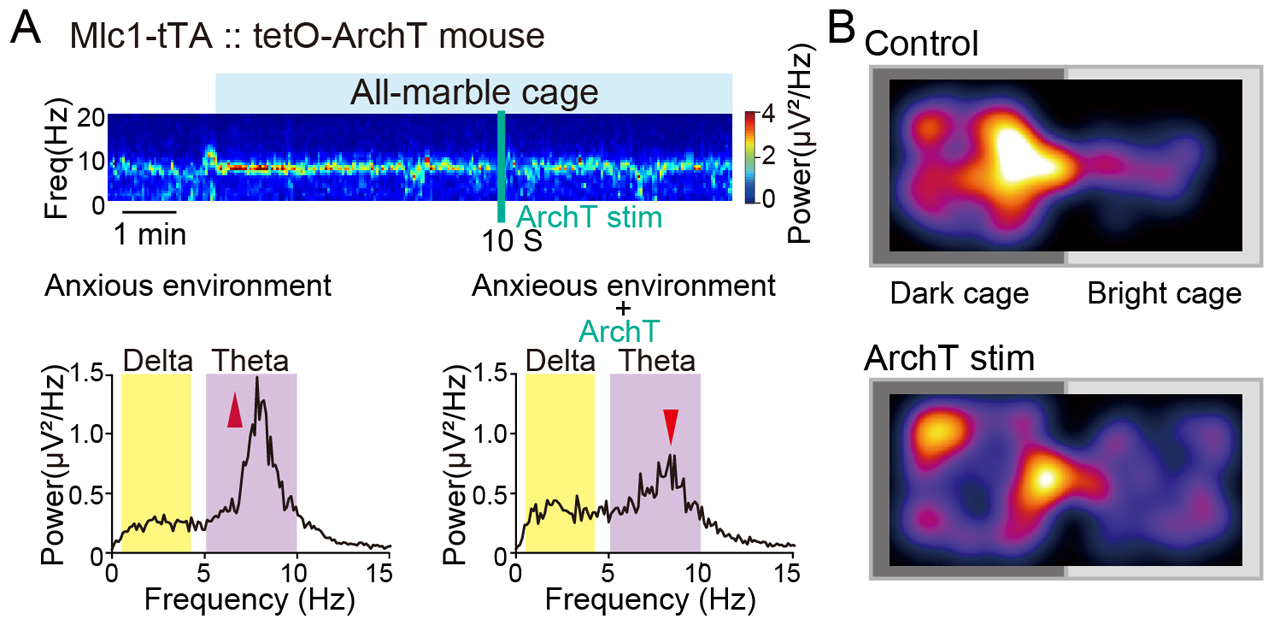Anxiety is often attributed to an unconscious assessment of the environment and detection of potential danger. Whilst moderate anxiety is therefore advantageous for survival, excessive anxiety can lead to psychiatric disorders.
Now, researchers at Tohoku University have shed light on the intricate interactions between neurons and astrocytes within the habenula, a region of the brain associated with emotional processing. By subjecting mice to a scenario involving a floor scattered with marbles, the researchers observed behavioral responses indicative of anxiety.
The findings were detailed in the journal, Neuroscience Research, on February 10, 2024.
The habenula are a pair of small nuclei located above the thalamus. It is one of the few brain regions that controls both dopaminergic and serotonergic systems. As these neuromodulators play essential roles in a wide range of motivational and cognitive functions, habenula neuronal circuits are potentially relevant to controlling anxiety.
“Anxiety may appear to be an irrational emotion having only negative impacts on our life,” says Professor Ko Matsui of the Super-network Brain Physiology lab at Tohoku University, who led the research. “However, well-tuned anxiety is a guide provided by our unconsciousness which allows us to navigate the hidden dangers. Such tuning may be accomplished by the actions of the habenula.”
Mice perceive smooth glass marbles as potentially harmful objects due to their unfamiliarity. Mice tend to bury marbles in saw dust bedding to keep these uncomfortable objects out of sight. Here, the researchers created a chamber filled with marbles to create an inescapable, maximum anxiety environment.
They noticed increased neuronal activity in the theta band (5 to 10 Hz) frequency, an increase in local brain blood volume, and acidification occurring in the astrocytes of the habenula when the mice were placed in the all-marble cage. When the habenular astrocytes were artificially alkalized to counter the acidification, the theta band neuronal activity diminished. When the mice were allowed to choose between the brightly lit all-marble cage and a dark and comfortable cage, the mice naturally chose to stay in the dark cage. However, when the habenular astrocytes were optogenetically alkalized, the mice ventured more into the bright cage.
Astrocytes are non-neuronal cells that occupy approximately half of the brain. They have been shown to control the local ionic and metabotropic environment in the brain. Astrocytes also release transmitters that can affect neuronal activity in the vicinity. The results of this study suggest that the theta band habenular neuronal activity is regulated by the activity of astrocytes. Thus, habenular astrocytes were considered to play a role in regulating anxiety.
Lead study investigator, Wanqin Tan, says that future treatment of anxiety disorders may be realized by developing a therapeutic strategy that adjusts astrocyte activity in the habenula. “Habenular astrocytes tune the ‘marble blues.’ Based on this, we expect that methods to cope with anxiety could be developed.”

Habenular astrocytes tuning the marble blues. Mice usually do not prefer novel objects and the presence of smooth glass marbles makes them uneasy and anxious. In the marble burying test, the number of marbles buried in the sawdust bedding is counted and administration of anti-anxiety drugs has been shown to reduce the buried number. However, with the floor filled with marbles, the mouse is faced with inescapable anxiety. Theta-band neuronal activity is observed in the habenula when the mouse is in such an anxiogenic environment. With optogenetic alkalinization of habenular astrocytes, the theta-band neuronal activity becomes dissipated. These experiments suggest the role of habenular astrocytes in regulating the tone of anxiety. * The animal in this figure is not a real photograph but a drawn picture and is depicted for the sole purpose of presenting the circumstantial image of the research only. ©Wanqin Tan, Ko Matsui

Habenular astrocyte acidification in the anxiogenic environment. (A) Fluorescence sensor protein E2GFP is sensitive to changes in the intracellular pH. The green emission in response to purple light excitation does not change much with changes in the pH; however, the orange emission is largely decreased with pH acidification. E2GFP was selectively expressed in astrocytes and fluorescence fluctuation in the habenula was analyzed using the fiber-photometry method. (B) When the mouse was placed in the anxiogenic all-marble cage, ~ 8 Hz theta-band neuronal activity was detected in the local field potential recorded using a pair of electrodes placed in the habenula. With the optical fiber placed in the habenula, green emission fluorescence showed a downward deflection when the mouse was placed in the all-marble cage. This is the result of an increase in the local brain blood volume. The expansion of the blood vessel diameter likely obstructs the emitted fluorescence from reaching the optical fiber for detection. The orange emission showed a larger downward deflection compared to the green emission. This shows that intracellular pH in the habenular astrocytes was acidified and the local brain blood volume increased when the mice were anxious. ©Wanqin Tan, Ko Matsui

Optogenetic alkalinization of habenular astrocytes results in the reduction of anxiety. (A) Archaerhodopsin-T (ArchT) is a light-activated outward proton pump. Photoactivation of ArchT expressed in cell membranes results in intracellular alkalinization. ArchT was selectively expressed in astrocytes and the optical fiber placed in the habenula was used for photoactivation of ArchT. When the mouse was placed in an anxiogenic, all-marble cage environment, theta-band neuronal activity was detected. Photoactivation of the ArchT in the habenular astrocytes led to the reduction of the theta-band. (B) Mice normally prefer a dark room with comfortable bedding. When the mouse was placed in a two-way chamber with a dark room and a bright room with an all-marble floor, the mouse tended to stay in the dark room. However, when the ArchT in the habenular astrocytes were photoactivated, the mouse ventured to the bright room and traveled more in the bright room. These results suggest that when the acidic reaction of the habenular astrocytes is countered by optogenetic alkalinization, anxiety can be reduced. ©Wanqin Tan, Ko Matsui
Publifation Details:
Title: Anxiety control by astrocytes in the lateral habenula
Authors: Wanqin Tan, Yoko Ikoma, Yusuke Takahashi, Ayumu Konno, Hirokazu Hirai, Hajime Hirase, Ko Matsui
Journal: Neuroscience Research
DOI: https://doi.org/10.1016/j.neures.2024.01.006
Embargo date: February 10, 2024
Authors: Wanqin Tan, Yoko Ikoma, Yusuke Takahashi, Ayumu Konno, Hirokazu Hirai, Hajime Hirase, Ko Matsui
Journal: Neuroscience Research
DOI: https://doi.org/10.1016/j.neures.2024.01.006
Embargo date: February 10, 2024
Contact:
Ko Matsui,
Super-network Brain Physiology, Graduate School of Life Sciences,
Tohoku University
Email: matsui@med.tohoku.ac.jp
Website: http://www.ims.med.tohoku.ac.jp/matsui/
Ko Matsui,
Super-network Brain Physiology, Graduate School of Life Sciences,
Tohoku University
Email: matsui@med.tohoku.ac.jp
Website: http://www.ims.med.tohoku.ac.jp/matsui/

